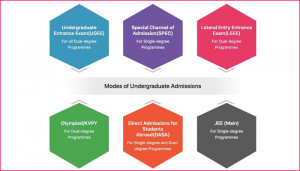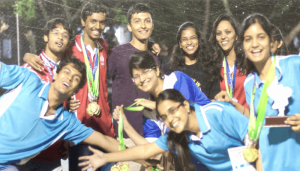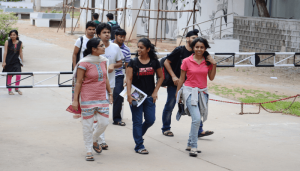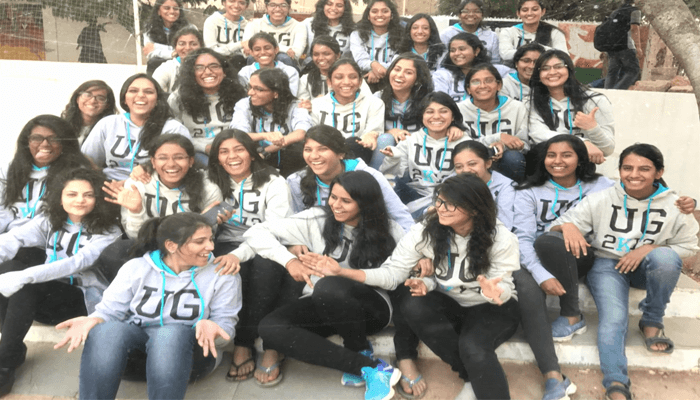As International Institute of Information Technology Hyderabad kicks off its admission process for the academic year 2020-21, here’s a low-down on different modes of admission, with the spotlight on the ‘Diversity’ channel where the ‘extraordinary’ are welcomed – both in terms of talent as well as circumstances. Read On.
‘Girls Outperform Boys’. Headlines like this highlighting gender differences in academic performance at the primary and high school level are commonplace. However, similar trends are hard to find at the college level, especially in technical and professional courses. Not that it refers to a lack in aptitude among girls. Au contraire, if results of the 2018 Technology and Engineering Literacy (TEL) Exam are any indication, many girls demonstrate a better aptitude for technical subjects. (They outscored boys in every category of engineering and technology concepts even though fewer girls take such classes in school as compared with boys). While the exam itself was conducted on 15,400 eighth grade students as part of America’s National Assessment of Educational Progress, it has implications worldwide because we continue to see a technically skilled workforce heavily skewed in favour of men. This is because despite their proclivity towards the Sciences, girls are still not encouraged enough to pursue scientific subjects as often as boys.
A look at the gender ratio in the country’s leading technical institutes reinforces these beliefs. It was this gender gap in representation of women at Indian premier institutes such as the IITs that prompted the Government to create special women-only seats for admission into the IITs. In 2018, the Ministry of Human Resource Development mandated 14% of total number of seats in IITs to be filled up by women candidates. It turned out to be such a success that while 1062 girls qualified for admission through the merit list, the total number of girls who got admitted amounted to 1841 in number. This led to the government increasing the percentage of supernumerary seats to 17% in 2019. The intent is to eventually have at least upto 20% of female representation in BTech programmes by 2020-21.

Multiple Modes of Admission
At IIITH, since its inception in 1998, there has been an emphasis on diversity on campus by having various channels of admission into its single and dual degree programmes. Commenting on the JEE exam and the ranking system itself, Prof. P. J. Narayanan, Director of IIITH, says,” Any institute in our view should have multiple ways of identifying talent and bringing in students. In our country, since we can’t have subjective ways of identifying, unfortunately we need to have rankings. The ability to do well in exams, the ability to do well on campus and the ability to do well in life have no correlation. Hence there’s a need to have multiple types of ‘catchment’ to rank students in their own streams independently.”
Besides the most popular JEE (Main) route, IIITH has other admission options such as those for students who either hold a foreign passport or have studied abroad (Direct Admissions for Students Abroad – DASA), an in-house entrance exam for all dual-degree programmes, and a lateral entry entrance exam into dual-degree programmes for students completing their 2nd year BE or BTech from other institutes. But the modes of admission that are truly unique are the Special (SPEC) Channel of Admission and the Olympiad. The SPEC channel is especially meant for those who have been identified under the UDAAN scheme of CBSE and to graduates of class 12 of the 10+6 programmes for predominantly rural students conducted by institutions like the Rajiv Gandhi University of Knowledge Technologies (RGUKT). The UDAAN itself is a government-initiative to encourage girl students and facilitate their aspiration of joining prestigious engineering institutions by giving them weekend coaching classes and study materials. Girl students who are beneficiaries of the UDAAN scheme are eligible to appear for a specially conducted entrance exam by IIITH. The intent is to encourage the extraordinary – not just in terms of talent but also background. “A bulk of these students come from rural regions and socio-economically disadvantaged sections of society,” says Prof. Jayanthi Sivaswamy, Dean (Academics) at IIITH. The RGUKT is an institution run by the government to address the needs of the rural underprivileged students. Shortlisted applicants from both the streams are given full financial assistance in a bid to boost their passion towards technology.
For students who have been selected to represent India at international olympiads such as the Science Olympiad, the Mathematics Olympiad, Linguistics Olympiad and the Olympiad on Informatics, the institute waives off qualifying exams, directly inviting them for an interview. There is also the Kishore Vaigyanik Protsahan Yojana (Hindi for Young Scientist Incentive Plan), a scholarship programme funded by the Department of Science and Technology (DST) to encourage students to take up research in Sciences. Students who qualify in the KVPY exam are eligible to study at institutes such as the Indian Institute of Science (IISc) and the Indian Institutes of Science Education and Research (IISER). IIITH directly invites those obtaining a rank of 5000 or higher in the KVPY and will select top 100 of them for an interview.
More IITs, More Seats
This academic year, 25% of total number of JEE seats have been earmarked as a Diversity Channel for girl students at IIITH. While the early years of inception of this autonomous institute saw a decent enough ratio of women enrollments, the last four years in particular have witnessed an alarming decline in the same. “There could be many reasons. One of them being the launch of many more IITs. With practically one in every state, there are that many more engineering seats now available. From informal conversations with parents, we also found that parents (of girls particularly) prefer proximity to their home while choosing a place of study. So when there are options either close to or in their own home state, they wouldn’t want to venture out. Plus, in addition to an increase in the total number of seats, the introduction of supernumerary seats by the IITs too has diverted potential female candidates elsewhere,” says Prof. Sivaswamy. An analysis of female enrollments to the institute in the early years revealed a higher acceptance rate by applicants from AP/neighbouring states when offered a seat, reinforcing the proximity factor as being a compelling one. Interestingly though, it looks like this factor continues to prevail even in that last four years. In 2019, only 4 girls joined the BTech programme through the JEE Mains and all were from the home or neighbouring states.
Creamy Layer
Emphasising that the diversity scheme is unlike a reservation or a quota system in the regular sense, Prof. P.J. Narayanan says that these seats are kept apart for female candidates, but girls are not eligible for the regular seats unless the Diversity Channel seats are all filled up. For example, if there are 100 seats and 25 girls in the first 100 IIITH ranks, then the diversity channel will be filled up, opening up the regular channel seats to everyone. “In theory, it could lead to more than 25% of total student intake being women. The cut-off rank under this scheme is the same as the cut-off under the open quota. So in that sense, this works differently from traditional reservations,” clarifies the Director. In response to queries on a possible dilution of standards thanks to this scheme, he says, “There’s no lowering of standards. To be eligible for this channel, students need to be in the top 1 percentile of JEE Mains (i.e. JEE-Main score is 99 percentile or higher). That is extremely good. If you want to take the ranks as a measure of intellect, perhaps the bands have some meaning, such as the top 500 ranks, the next 1000. Between 50,000-1 lakh ranks, there might not be any difference in the intellect or ability of the students. You can pick anybody.”

Quality, Opportunity, Safety
But what does IIITH offer women in particular? Prof. Sivaswamy is of the opinion that the most compelling reason for girls to seek out IIITH is the excellent education provided by the institute. “But even beyond undergraduate education, it is the access to incredible opportunities, to both girls and boys, in the form of not just jobs but other universities of repute for higher education that we provide,” she says. For parents of potential girl candidates, safety of their wards assumes priority in seeking out a place for higher study. In the case of IIITH, a lesser-known or publicized fact is the single-entry access to the institute. “Unlike other institutes, some of which are spread out on smaller campuses, ours is probably the only one with a single gate for entry and exit. With a biometric access at this point, it makes access control that much easier,” explains Prof. Sivaswamy. With no curfew in place for boys or girls, and labs on campus open 24×7, there are no restrictions on the movements of students either on campus or outside. “The only restriction is that ‘cross-entry’ is not allowed in hostels, i.e, boys cannot enter girls hostels and vice-versa. For parents who express apprehension on the lack of curfew, we ask them to trust their wards. With freedom comes responsibility, and even if students make mistakes and falter, we are always there to help,” says Prof. Sivaswamy.

Flexible and Encouraging
The institute constantly sends out a subtle message that it is there to help anyone who needs it. In fact students who are registered for an 8-semester BTech programme and find it tough initially are encouraged to lighten their load. “The 8-semester plan is not set in stone. If they’ve had a bad start, they are told to drop the second semester, take a break and then come back,” says Prof. PJN. Besides actively encouraging women in STEM, the institute also believes that finance should never be a bar to pursuing education. Financial assistance in various forms is provided, from reduced and voluntary application fee (to those who demonstrate an inability to pay for it), to arranging for scholarships in association with companies, to getting loan approvals for paying tuition fee and in some cases even providing a stipend. All this will help create a melting pot of ideas on campus and a welcoming environment where students from all backgrounds can flourish.

Sarita Chebbi is a compulsive early riser. Devourer of all news. Kettlebell enthusiast. Nit-picker of the written word especially when it’s not her own.


Its great to hear about diversity inclusion at IIITH, but the article mostly speaks about UG program. Can you please share some thoughts about diversity in PG programs. Are there any special steps being taken to include more women in STEM related research in PG.
Saanvi says:My daughter got 10634 rank in JEE Mains 2020. We have applied in Gender Diversity is there a chance to get seat in IIIT Hyderabad. Please suggest. Thank You.
srividya says: